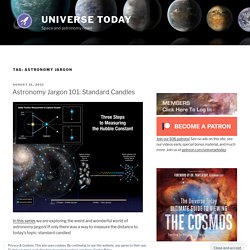Physics
> Vbunce
> Subjects
> Science
The Map of Quantum Physics. The Map of Physics. Astronomy jargon Archives. In this series we are exploring the weird and wonderful world of astronomy jargon!

If only there was a way to measure the distance to today’s topic: standard candles! Continue reading “Astronomy Jargon 101: Standard Candles”
How Far Can We Go? Limits of Humanity.
Build your own Galilean telescope - skyatnightmagazine. This project is a homemade, working replica of a very famous instrument.

In 1609 Galileo designed and built his first telescope, and we thought it would be interesting to try and make our own telescope based on this instrument.
When Will the Earth Get Hit by Another Asteroid?
Your odds of dying in an asteroid impact are about one in 700,000.

Why do asteroids explode high in the atmosphere?
If you've ever watched a bad movie about an asteroid hitting the Earth (and there are so many that if I have to see another one I swear I'm rooting for the asteroid) then you might have noticed that the asteroid itself always slams into the Earth's surface, and it's the impact itself that does all the damage.

Actually, you may not have noticed, because it happens so often and is such a trope that you might just take it for granted, like the air you breathe. Oh, but that air is important. If the asteroid is small-ish, say a few dozen to a few hundred meters across, then air is critical. That becomes obvious if you turn away from the silver screen and instead watch an actual asteroid impact … like the one that happened on February 15, 2013, over the city of Chelyabinsk, Russia. This dashboard cam video shows the entire event.
Whack 'em or nuke 'em: How to deflect a killer asteroid. A new paper just published by scientists from various NASA and the National Nuclear Security Administration labs looks at the best way to prevent an impact from an asteroid headed toward Earth.

Their conclusion: Above a certain size, roughly 300 meters across or so, the best thing to do is nuke it. Seriously! But not for the reason you think.
One Year After Russia’s Sky Exploded. Today (or rather tonight due to time zone issues) is the first anniversary of the asteroid impact over the Russian city of Chelyabinsk.

What follows below is a retrospective on the event. Inspired by this, I also wrote a longform piece for Slate’s Big Questions section, asking, “When Will the Earth Get Hit By Another Asteroid?”
Phil Plait: How to defend Earth from asteroids. What’s Really Inside A Proton?
At a fundamental level, the Universe is composed of indivisible particles.

Every structure contains “uncuttable” constituents that cannot be divided further. Even protons and neutrons are composite: containing fundamental quarks and gluons. There aren’t just three quarks inside each one, but a sea of particles. Since quarks have: mass, electric charge, color charge, and weak force couplings, they interact with all known particles.
We've mapped a million previously undiscovered galaxies beyond the Milky Way. Take the virtual tour here.
Astronomers have mapped about a million previously undiscovered galaxies beyond the Milky Way, in the most detailed survey of the southern sky ever carried out using radio waves.

The Rapid ASKAP Continuum Survey (or RACS) has placed the CSIRO’s Australian SKA Pathfinder radio telescope (ASKAP) firmly on the international astronomy map. While past surveys have taken years to complete, ASKAP’s RACS survey was conducted in less than two weeks — smashing previous records for speed. Data gathered have produced images five times more sensitive and twice as detailed as previous ones.
Planets and Other Worlds. An Astronomer Explains Black Holes at 5 Levels of Difficulty.
The NSF Inouye Solar Telescope's First Movie (Cropped) - NSO - National Solar Observatory. Caption: The Daniel K.

Inouye Solar Telescope has produced the highest resolution observations of the Sun’s surface ever taken.
If the Moon Were Only 1 Pixel - A tediously accurate map of the solar system. Mercury Venus Earth.

(37) NASA's Guide To Black Hole Safety. Mapping Saturn’s Moons. Bringing the Universe to America's Classrooms. How to View the Moon and Mars in Google Earth. Tibees. How Aboriginal traditions describe the complex motions of planets. The five planets we can see by naked eye were known to the ancient Greeks as “asteres planetai”, meaning “wandering stars”, due to their wandering journey across the sky relative to the fixed stars. This is where we get the word “planet”. But knowledge of the planets and their movements goes back much further, being prominent in the traditions of the oldest continuing cultures in the world.
Stuff in Space. Uses or Simple Applications of Electromagnetism in Technology and Life.
Written by: sriram balu • edited by: Swagatam • updated: 12/1/2011 Electromagnetism has created a revolution not only in the field of engineering, but also in various other fields like medicine, space, construction etc. Read here to know about various uses of electromagnetism in everyday life from household appliances to research labs. Uses of Electromagnetism in LifeWhatever powered devices we use, from table clocks to microwave ovens, have some form of electromagnetic principle involved in their functioning.
What is RFID?
RFID stands for Radio Frequency IDentification, a technology that uses tiny computer chips smaller than a grain of sand to track items at a distance.
RFID "spy chips" have been hidden in the packaging of Gillette razor products and in other products you might buy at a local Wal-Mart, Target, or Tesco - and they are already being used to spy on people. Each tiny chip is hooked up to an antenna that picks up electromagnetic energy beamed at it from a reader device.
Facts About Maglev. Magnetic levitation transport, or maglev, is a modern form of transportation that suspends, guides and propels vehicles (especially trains) via electromagnetic force.
This High-Tech method can be significantly faster than wheeled mass transit systems, potentially reaching velocities comparable to turboprop and jet aircraft (550 to 700 km/h) in regular service. Maglev systems represent a revolutionary transport innovation. At the same time, they can also function as a technology development platform (e.g., superconductors, new materials). They can, in certain cases, bring positive economic benefits through the optimization of spatial networking, travel time reduction and resource efficiency.
Electromagnetic Energy: From Motors to Lasers. Uses or Simple Applications of Electromagnetism in Technology and Life.
Written by: sriram balu • edited by: Swagatam • updated: 12/1/2011 Electromagnetism has created a revolution not only in the field of engineering, but also in various other fields like medicine, space, construction etc.
News - NASA Space Telescopes Provide a 3D Journey Through the Orion Nebula. What causes lift?
Image and Video Library.
Beyond Angry Birds, Five Apps That Test Your Physics Skills. The Particle Adventure. US NSF - Physics Classroom Resources. High School (Grades 9-12) Physics Activities, Lesson Plans, Worksheets & Handouts. Science Xplained. Science Xplained is a collection of video podcasts that tell the stories of the science behind everyday topics.
Dr. Ainissa G. Ramirez, self-proclaimed science evangelist and associate professor of mechanical engineering and materials science at Yale University, is the dynamic host of the series. Filter Resources by Grade: Videos. The electromagnetic spectrum. Free Online Physics Courses. Physics & Math. Rader's PHYSICS 4 KIDS.COM.
The Physics Classroom. Physics.org. Courses: Science: Physics. Peanut Software Homepage. Myphysicslab – physics simulation with java. Math, Physics, and Engineering Applets. Physics in Pictures. Www.physicscentral.com. The Universe and More. Physicsworld.com homepage. Teaching Resources. NASA Physics and Engineering. Refraction. Space - Digital Education Resources. The Famous Feynman Lectures on Physics: The New Online Edition (in HTML5)
Physics Applets & Animations. Math, Physics, and Engineering Applets. HyperPhysics Concepts. General Physics Java Applets. Physics Java Applets. Simple Machines. Go to the Head of the Solar System.
How Things Fly. Good Astronomy Activities on the WWW. The Higgs Boson and Its Discovery Explained with Animation. Evolution of the Universe - GigaPan Time Machine. Hollywood Science - Build a Catapult.
Physics Study Guides
Amusement Park Physics.










